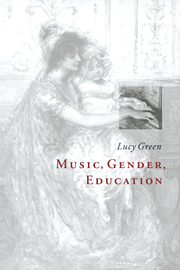Book contents
- Frontmatter
- Contents
- Acknowledgments
- 1 Introduction
- PART I MUSICAL MEANING AND WOMEN'S MUSICAL PRACTICE
- 2 Affirming femininity: women singing, women enabling
- 3 From affirmation to interruption: women playing instruments
- 4 Threatening femininity: women composing/improvising
- 5 Towards a model of gendered musical meaning and experience
- PART II GENDERED MUSICAL MEANING IN CONTEMPORARY EDUCATION
- Bibliography
- Index
3 - From affirmation to interruption: women playing instruments
Published online by Cambridge University Press: 20 November 2009
- Frontmatter
- Contents
- Acknowledgments
- 1 Introduction
- PART I MUSICAL MEANING AND WOMEN'S MUSICAL PRACTICE
- 2 Affirming femininity: women singing, women enabling
- 3 From affirmation to interruption: women playing instruments
- 4 Threatening femininity: women composing/improvising
- 5 Towards a model of gendered musical meaning and experience
- PART II GENDERED MUSICAL MEANING IN CONTEMPORARY EDUCATION
- Bibliography
- Index
Summary
DISPLAY AS PART OF INSTRUMENTAL PERFORMANCE
The woman instrumentalist is on display, and she does to that extent participate in the same discourse as the woman singer. But in certain respects, her display takes on rather different connotations. The differences vary in degree according to the performance context, the instrument played, the subject-position of the listener and a variety of other factors. For example, in an early nineteenth-century domestic setting, from the perspective, of most observers, a woman pianist would have given rise to display-delineations that were to all intents and purposes just as affirmative as those of a woman singer; whereas on a public stage of the same era, a female trumpeter sitting in the ranks of an otherwise entirely male orchestra would have incurred radically different display-delineations, and in fact was quite unheard of. Why is it that – like singing – some instruments have for centuries been welcomed by women, and have been seen as acceptable or even desirable feminine accomplishments, whereas – unlike singing – certain other instruments have at various times been shunned by women, frowned upon or even prohibited?
I will approach this question through suggesting some fundamental, qualitative differences between the kinds of display delineations that arise from women's singing practices and those that arise from women's instrumental practices. To begin with I will present the discussion through a comparision of extremes: between highly affirmative singing practices on one hand and prohibitive or very unusual instrumental practices on the other. Later I will go on to consider my arguments in the light of concrete historical examples, including instruments that have been common as well as those that have been unusual for women.
- Type
- Chapter
- Information
- Music, Gender, Education , pp. 52 - 81Publisher: Cambridge University PressPrint publication year: 1997



